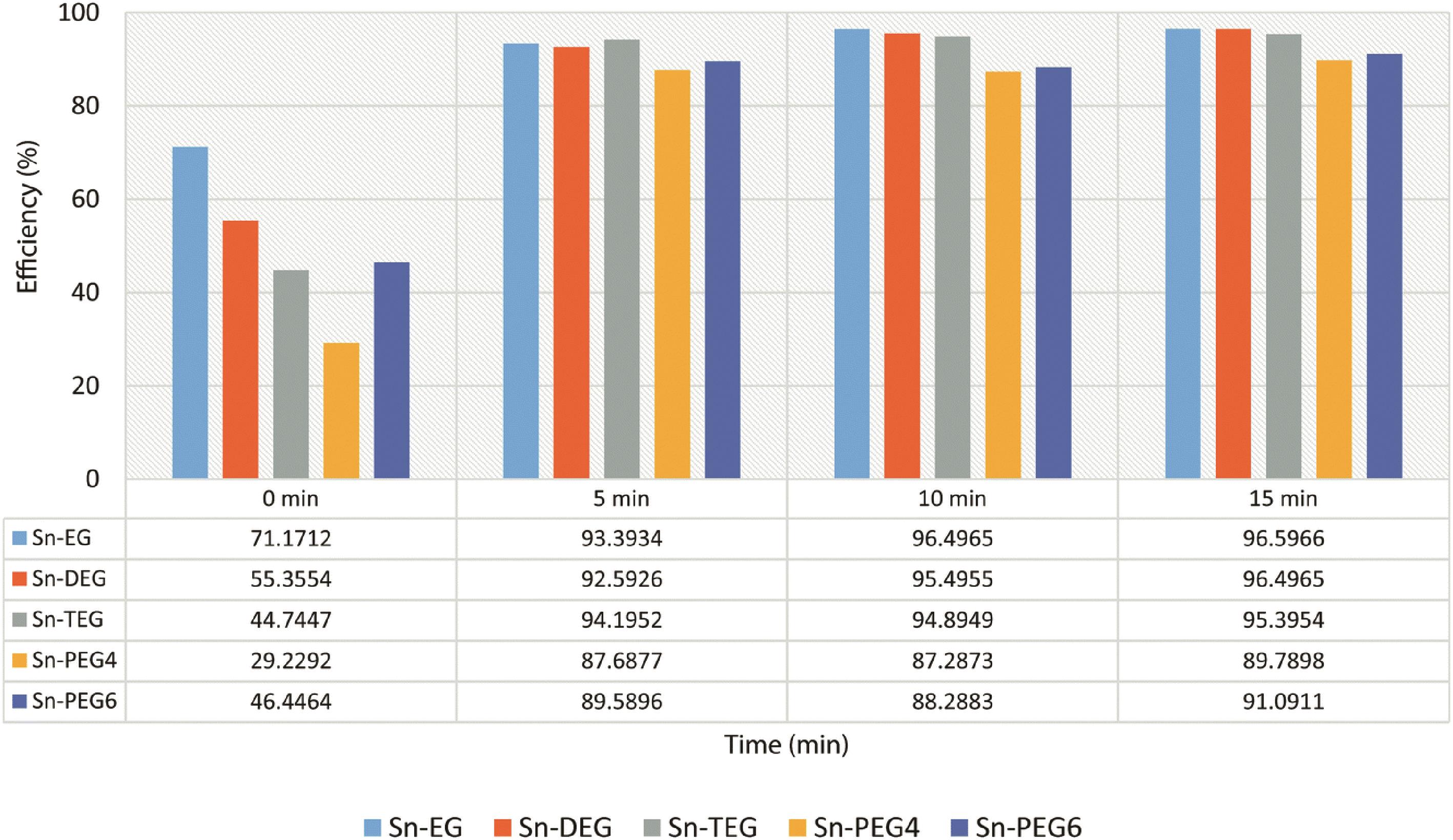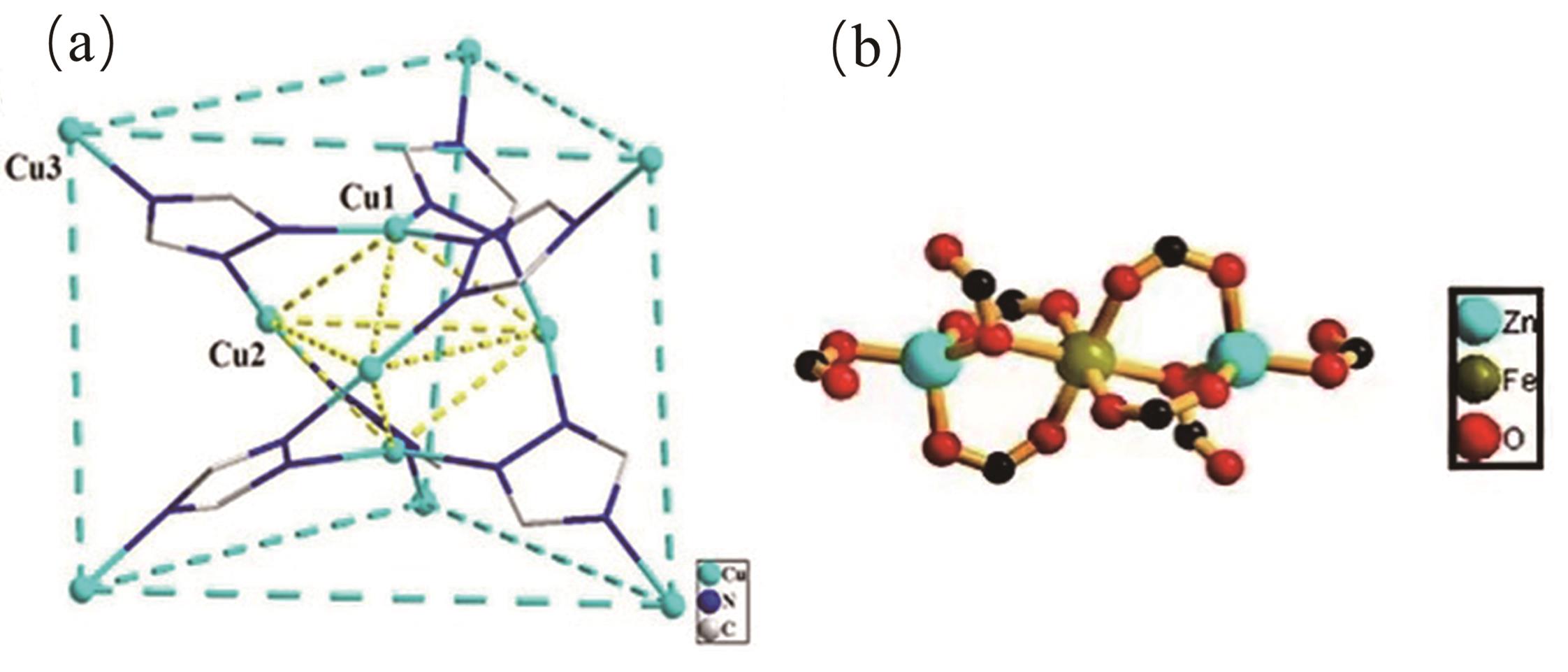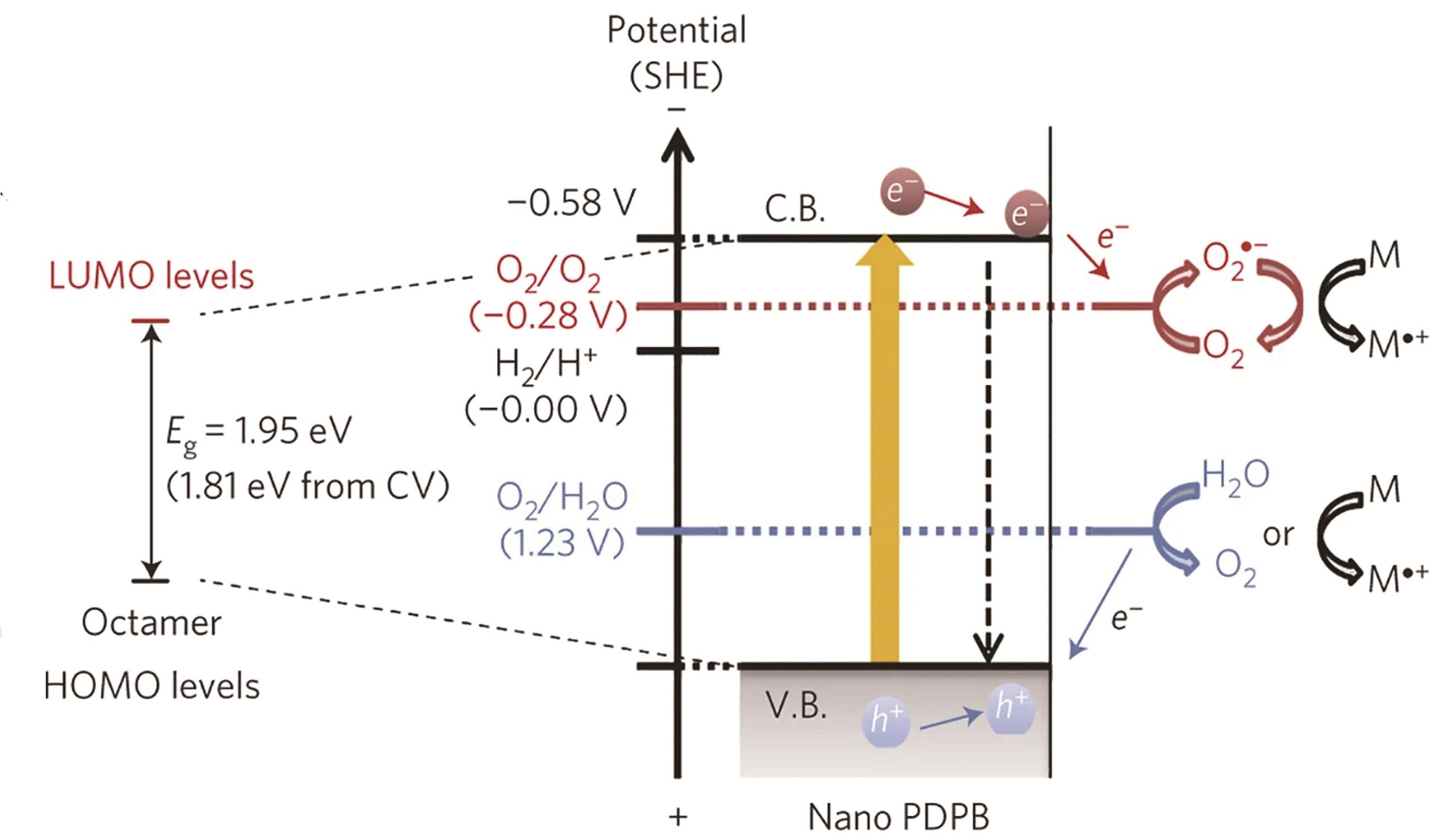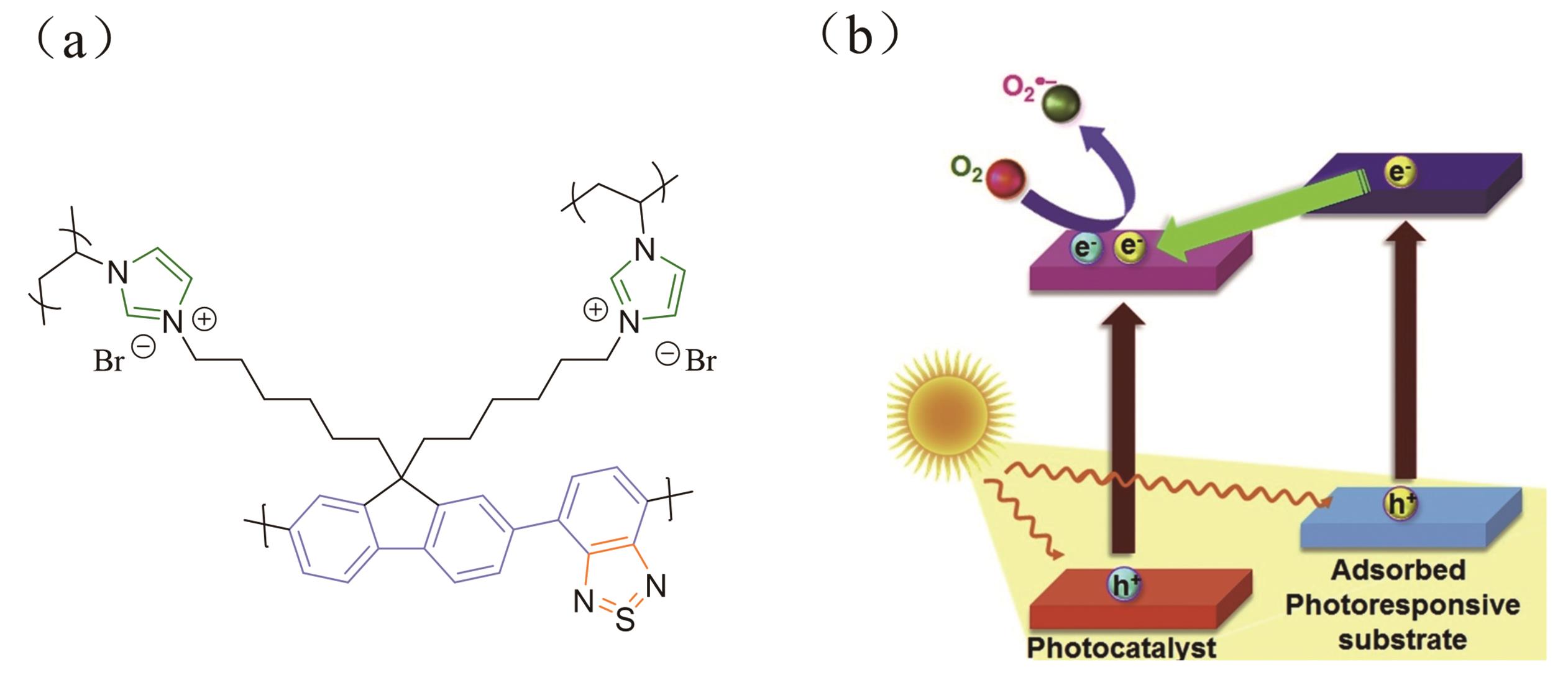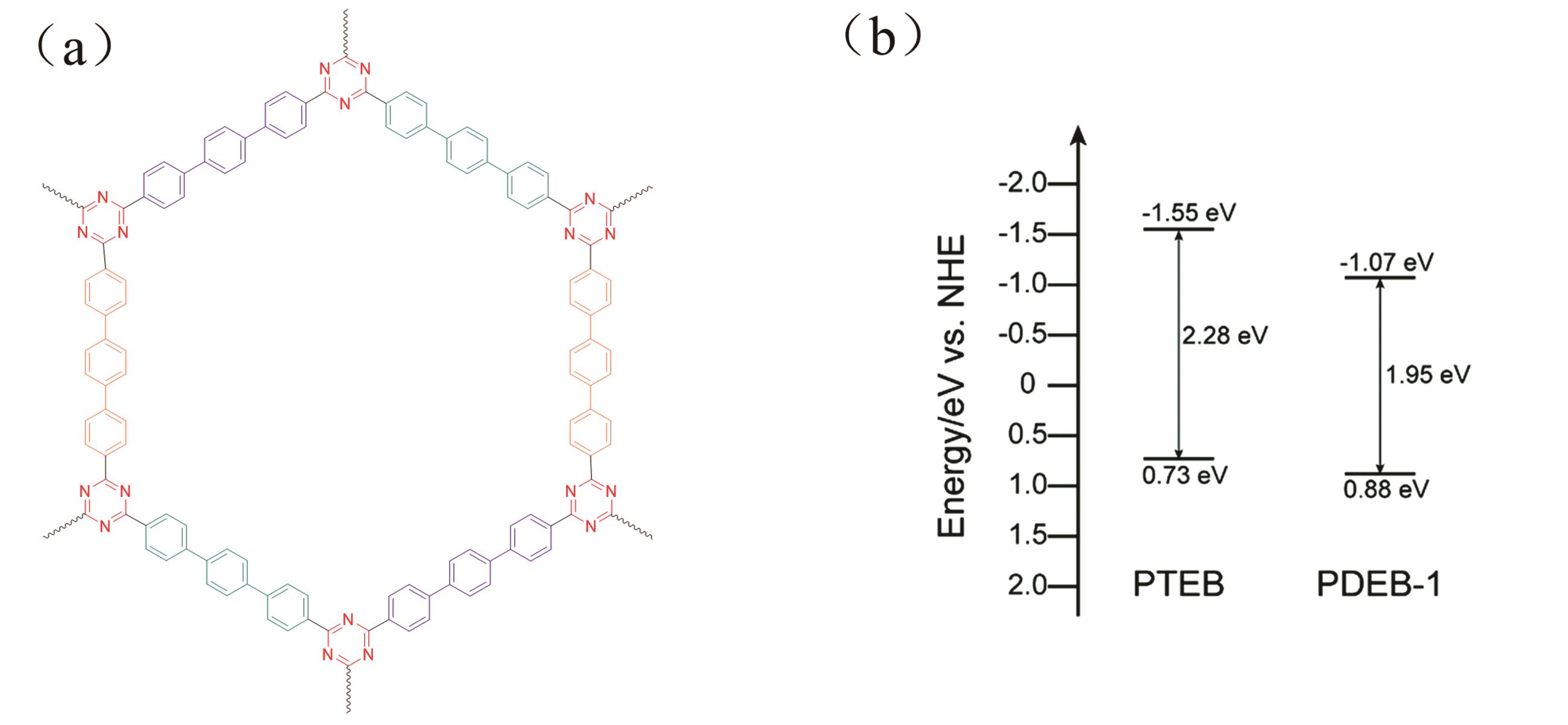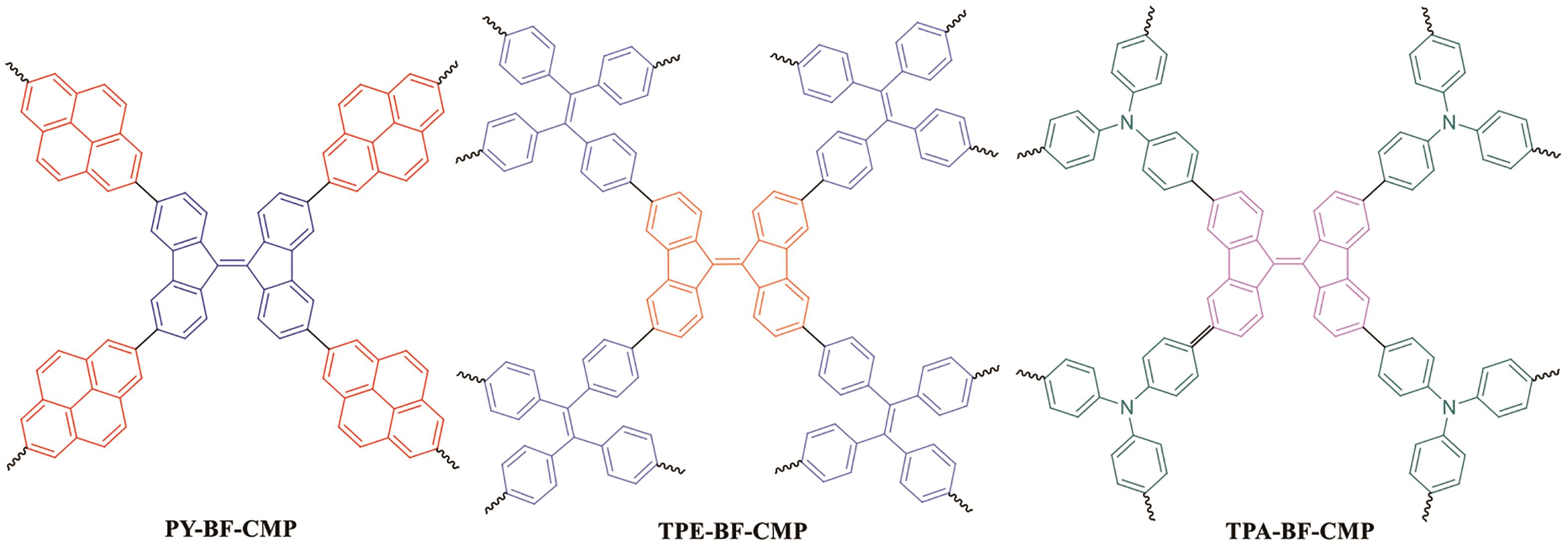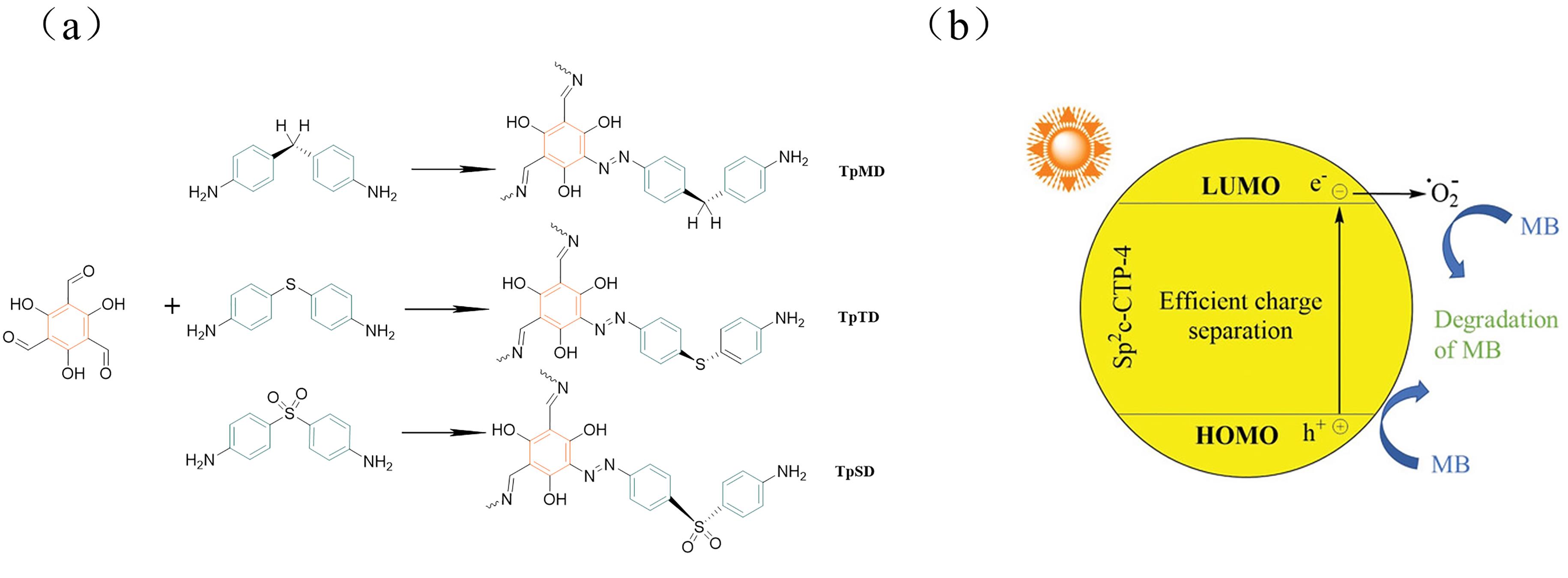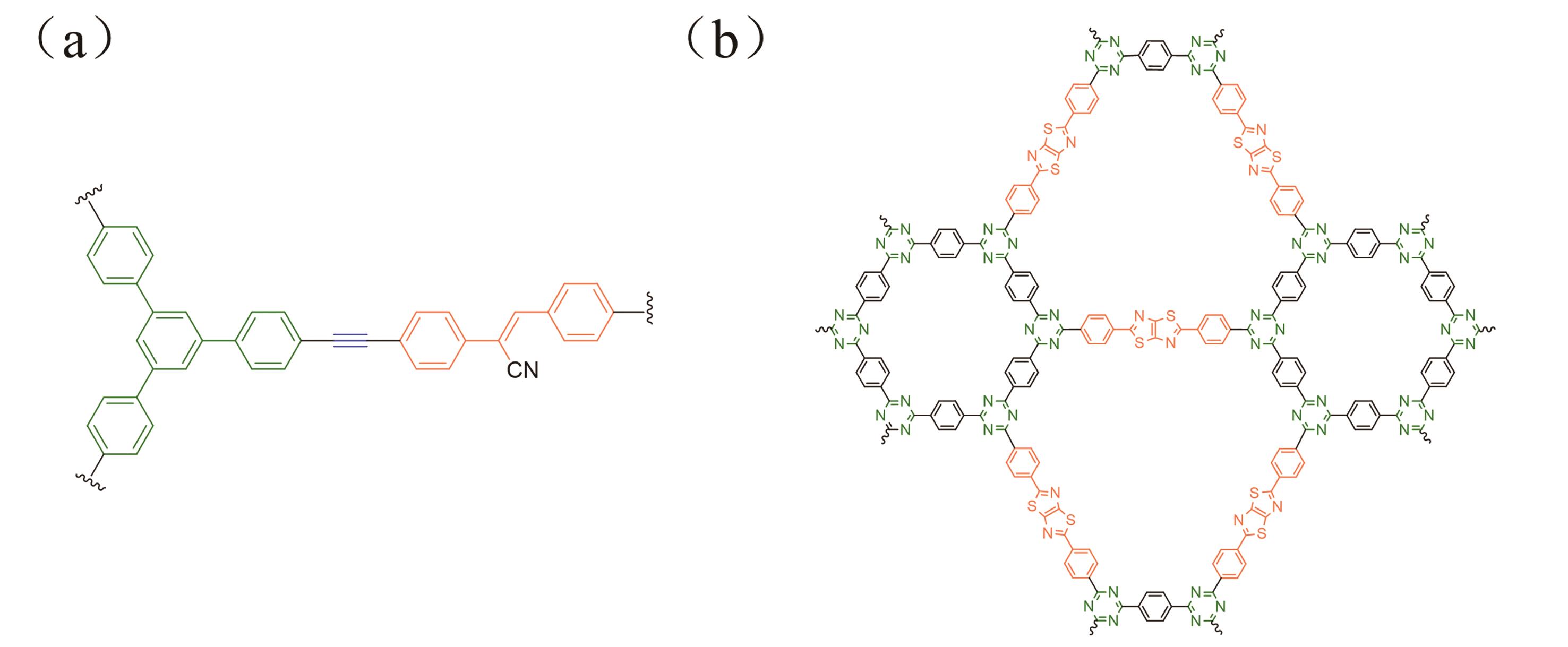
Chinese Journal of Applied Chemistry ›› 2023, Vol. 40 ›› Issue (5): 681-696.DOI: 10.19894/j.issn.1000-0518.220335
• Review • Previous Articles Next Articles
Research Progress on Photocatalysts for Degradation of Organic Pollutants in Printing and Dyeing Wastewater
Xue-Bo LEI1, Hui-Jing LIU1( ), He-Yu DING1, Guo-Dong SHEN1, Run-Jun SUN1,2
), He-Yu DING1, Guo-Dong SHEN1, Run-Jun SUN1,2
- 1.School of Textile Science and Engineering,Xi′an Polytechnic University,Xi′an 710048,China
2.State Key Laboratory of Intelligent Textile Material and Products,Xi′an Polytechnic University,Xi′an 710048,China
-
Received:2022-10-13Accepted:2023-03-09Published:2023-05-01Online:2023-05-26 -
Contact:Hui-Jing LIU -
About author:liuhuijing@xpu.edu.cn
-
Supported by:the National Natural Science Foundation of China(21802106);the China Postdoctoral Science Foundation(2019M653860XB);the Natural Science Basic Research Program of Shaanxi(2021JQ-681)
CLC Number:
Cite this article
Xue-Bo LEI, Hui-Jing LIU, He-Yu DING, Guo-Dong SHEN, Run-Jun SUN. Research Progress on Photocatalysts for Degradation of Organic Pollutants in Printing and Dyeing Wastewater[J]. Chinese Journal of Applied Chemistry, 2023, 40(5): 681-696.
share this article
Add to citation manager EndNote|Ris|BibTeX
URL: http://yyhx.ciac.jl.cn/EN/10.19894/j.issn.1000-0518.220335
| Catalysts | Light/nm | Mass/mg | Substrates | Concentration | Time/min | Efficiency/% | Ref. |
|---|---|---|---|---|---|---|---|
| V2O5 NWs | - | 2.5 | RhB | 20 mL(23 mg/L) | 70 | 95 | [ |
| Sn-TEG | 254 | 20 | MB | 50 mL(10 mg/L) | 15 | 96.6 | [ |
| Ag@Zn2TiO4 | 200~700 | 0.4 | RhB | 40 mL(5 mg/L) | 90 | 97 | [ |
| CZTS | 400~700 | 25 | RhB | 50 mL(194 mg/L) | 4 | 100 | [ |
| Se2.6%-ZnS | 200~700 | 40 | Trypan blue | 50 mL(15 mg/L) | 180 | 99 | [ |
| CST-T | 365 | 100 | RhB | 50 mL(100 mg/L) | 200 | 75 | [ |
| Bi4Ti3O12/BiOBr | 400~700 | 20 | Acid blue 83 | 100 mL(5 mg/L) | 180 | 100 | [ |
| 0.9BiOBr/0.1Ba0.8Sr0.2TiO3 | 200~400 | 20 | Direct blue 5B | 200 mL(20 mg/L) | 180 | 98 | [ |
Table 1 Degradation activity of inorganic semiconductor materials containing metal ions towards organic dyes
| Catalysts | Light/nm | Mass/mg | Substrates | Concentration | Time/min | Efficiency/% | Ref. |
|---|---|---|---|---|---|---|---|
| V2O5 NWs | - | 2.5 | RhB | 20 mL(23 mg/L) | 70 | 95 | [ |
| Sn-TEG | 254 | 20 | MB | 50 mL(10 mg/L) | 15 | 96.6 | [ |
| Ag@Zn2TiO4 | 200~700 | 0.4 | RhB | 40 mL(5 mg/L) | 90 | 97 | [ |
| CZTS | 400~700 | 25 | RhB | 50 mL(194 mg/L) | 4 | 100 | [ |
| Se2.6%-ZnS | 200~700 | 40 | Trypan blue | 50 mL(15 mg/L) | 180 | 99 | [ |
| CST-T | 365 | 100 | RhB | 50 mL(100 mg/L) | 200 | 75 | [ |
| Bi4Ti3O12/BiOBr | 400~700 | 20 | Acid blue 83 | 100 mL(5 mg/L) | 180 | 100 | [ |
| 0.9BiOBr/0.1Ba0.8Sr0.2TiO3 | 200~400 | 20 | Direct blue 5B | 200 mL(20 mg/L) | 180 | 98 | [ |
| Catalysts | Wave length/nm | Mass/mg | Substrates | Concentration | Time | Efficiency/% | Ref. |
|---|---|---|---|---|---|---|---|
| Ce-MOF-589 | - | 1 | MB | 40 mg/L(1 mL) | 15 min | 96 | [ |
| PTBMOF | 200~800 | 20 | Tartrazine | 23 mg/L | 24 h | 98.9 | [ |
| CuTz-1 | 200~800 | 12 | RhB | 12 mg/L(20 mL) | 22 min | 100 | [ |
| BMOF | 200~800 | 10 | MB | 3.7 mg/L | 90 min | 57 | [ |
Table 2 Degradation activity of MOFs towards organic dyes
| Catalysts | Wave length/nm | Mass/mg | Substrates | Concentration | Time | Efficiency/% | Ref. |
|---|---|---|---|---|---|---|---|
| Ce-MOF-589 | - | 1 | MB | 40 mg/L(1 mL) | 15 min | 96 | [ |
| PTBMOF | 200~800 | 20 | Tartrazine | 23 mg/L | 24 h | 98.9 | [ |
| CuTz-1 | 200~800 | 12 | RhB | 12 mg/L(20 mL) | 22 min | 100 | [ |
| BMOF | 200~800 | 10 | MB | 3.7 mg/L | 90 min | 57 | [ |
| Catalysts | Light | Mass/mg | Substrate | Concentration | Time | Efficiency/% | Ref. |
|---|---|---|---|---|---|---|---|
| TM-2-d | High pressure mercury lamp(500 W) | 1 000 | MB | 300 mg/L(2 000 mL) | 12 h | 100 | [ |
| ANP | 300~700 nm | 50 | MB | 37 mg/L(20 mL) | 200 min | 97 | [ |
| PCBM | 300~700 nm | 1.2 | RhB | 6.7 mg/mL(3mL) | 30 min | 90 | [ |
Table 3 Degradation activity of organic small molecules to organic dyes
| Catalysts | Light | Mass/mg | Substrate | Concentration | Time | Efficiency/% | Ref. |
|---|---|---|---|---|---|---|---|
| TM-2-d | High pressure mercury lamp(500 W) | 1 000 | MB | 300 mg/L(2 000 mL) | 12 h | 100 | [ |
| ANP | 300~700 nm | 50 | MB | 37 mg/L(20 mL) | 200 min | 97 | [ |
| PCBM | 300~700 nm | 1.2 | RhB | 6.7 mg/mL(3mL) | 30 min | 90 | [ |
| Catalysts | Wavelength | Mass/mg | Substrates | Concentration | Time | Efficiency/% | Ref. |
|---|---|---|---|---|---|---|---|
| 10%TrCMP/TiO2 | 300~700 nm | 26.25 | MB | 8.1 mg/L(35 mL) | 20 min | 92.5 | [ |
| Nano PDPB | λ>450 nm | 3.5 | MO | 3.27 mg/L(3.5 mL) | 240 min | 75 | [ |
| P-FL-BT-3 | 300~700 nm | 1 | RhB | 10 mg/mL(10 mL) | 70 min | 90 | [ |
| POPs-2 | λ>420 nm | 10 | CR | 10 mg/L(10 mL) | 90 min | 85 | [ |
| PTEB | λ>420 nm | 0.3 | RhB | 20 mg/L | 50 min | 100 | [ |
| Py-BF-CMP | λ>450 nm | 4 | RhB | 25 mg/L(20 mL) | 30 min | 81 | [ |
| TZCP-3 | λ>420 nm | 5 | RhB | 10 mg/L(100 mL) | 30 min | 100 | [ |
| TA-BGY | 200~1300 nm | 20 | MB | 30 mg/L(20 mL) | 8 h | 80 | [ |
| TpSD | 300~700 nm | 3 | Rh6G | 10 mg/L(30 mL) | 60 min | 99.2 | [ |
| sp2c-CTP-4 | 300~700 nm | 3 | MB | 40 mg/L(5 mL) | 90 min | 98 | [ |
| network-3 | 300~700 nm | 14.2 | MB | 4 mg/L | 90 min | 95 | [ |
| CTF-NWU-1 | λ>420 nm | 10 | RhB | 20 mg/L(50 mL) | 30 min | 99 | [ |
Table 4 Degradation activity of conjugated microporous polymers towards organic dyes
| Catalysts | Wavelength | Mass/mg | Substrates | Concentration | Time | Efficiency/% | Ref. |
|---|---|---|---|---|---|---|---|
| 10%TrCMP/TiO2 | 300~700 nm | 26.25 | MB | 8.1 mg/L(35 mL) | 20 min | 92.5 | [ |
| Nano PDPB | λ>450 nm | 3.5 | MO | 3.27 mg/L(3.5 mL) | 240 min | 75 | [ |
| P-FL-BT-3 | 300~700 nm | 1 | RhB | 10 mg/mL(10 mL) | 70 min | 90 | [ |
| POPs-2 | λ>420 nm | 10 | CR | 10 mg/L(10 mL) | 90 min | 85 | [ |
| PTEB | λ>420 nm | 0.3 | RhB | 20 mg/L | 50 min | 100 | [ |
| Py-BF-CMP | λ>450 nm | 4 | RhB | 25 mg/L(20 mL) | 30 min | 81 | [ |
| TZCP-3 | λ>420 nm | 5 | RhB | 10 mg/L(100 mL) | 30 min | 100 | [ |
| TA-BGY | 200~1300 nm | 20 | MB | 30 mg/L(20 mL) | 8 h | 80 | [ |
| TpSD | 300~700 nm | 3 | Rh6G | 10 mg/L(30 mL) | 60 min | 99.2 | [ |
| sp2c-CTP-4 | 300~700 nm | 3 | MB | 40 mg/L(5 mL) | 90 min | 98 | [ |
| network-3 | 300~700 nm | 14.2 | MB | 4 mg/L | 90 min | 95 | [ |
| CTF-NWU-1 | λ>420 nm | 10 | RhB | 20 mg/L(50 mL) | 30 min | 99 | [ |
| 1 | LIU H, YANG S, NI Y. Comparison of dye behavior from aspen HYP: dyes added in the HYP manufacturing process versus dyes added at the papermaking wet end[J]. J Wood Chem Technol, 2010, 30(2): 118-128. |
| 2 | FENG Q Y, GAO B Y, YUE Q Y, et al. Flocculation performance of papermaking sludge-based flocculants in different dye wastewater treatment: comparison with commercial lignin and coagulants[J]. Chemosphere, 2021, 262: 128416. |
| 3 | LI Q, DONG K, TU Y, et al. Current situation and problems of MBR treatment process in dye wastewater[C]. IOP Conf Ser: Earth Environ Sci, 2019, 358: 022043. |
| 4 | BELDEAN-GALEA M S, COPACIU F M, COMAN M V. Chromatographic analysis of textile dyes[J]. J AOAC Int, 2018, 101(5): 1353-1370. |
| 5 | UDDIN F. Environmental hazard in textile dyeing wastewater from local textile industry[J]. Cellulose, 2021, 28(17): 10715-10739. |
| 6 | MOYO S, MAKHANYA B P, ZWANE P E. Use of bacterial isolates in the treatment of textile dye wastewater: a review[J]. Heliyon, 2022, 8(6): e09632. |
| 7 | RAMAN C D, KANMANI S. Textile dye degradation using nano zero valent iron: a review[J]. J Environ Manage, 2016, 177: 341-355. |
| 8 | LEE M, NAM K T, KIM J, et al. Evaluation of ocular irritancy of coal-tar dyes used in cosmetics employing reconstructed human cornea-like epithelium and short time exposure tests[J]. Food Chem Toxicol,2017, 108: 236-243. |
| 9 | WARGALA E, SLAWSKA M, ZALEWSKA A, et al. Health effects of dyes, minerals, and vitamins used in cosmetics[J]. Women, 2021, 1: 223-237. |
| 10 | PASDARAN A, AZARPIRA N, HEIDARI R, et al. Effects of some cosmetic dyes and pigments on the proliferation of human foreskin fibroblasts and cellular oxidative stress; potential cytotoxicity of chlorophyllin and indigo carmine on fibroblasts[J]. J Cosmet Dermatol, 2022, 21(9): 3979-3985. |
| 11 | TU Y M, SHAO G Y, ZHANG W J, et al.The degradation of printing and dyeing wastewater by manganese-based catalysts[J]. Sci Total Environ, 2022, 828: 154390. |
| 12 | LIU Z C, KHAN T A, ISLAM M A, et al. A review on the treatment of dyes in printing and dyeing wastewater by plant biomass carbon[J]. Bioresour Technol,2022, 354: 127168. |
| 13 | DANG G H, TRAN Y B N, PHAM T V, et al. A cerium-containing metal-organic framework: synthesis and heterogeneous catalytic activity toward Fenton-like reactions[J]. ChemPlusChem,2019, 84(8): 1046-1051. |
| 14 | ZHANG X, WANG J, DONG X X, et al. Functionalized metal-organic frameworks for photocatalytic degradation of organic pollutants in environment[J]. Chemosphere, 2020, 242: 125144. |
| 15 | ZHAO T C, LIU R, LU J P, et al. Photocatalytic degradation of methylene blue solution by diphenylanthrazoline compounds[J]. J Phys Org Chem, 2017, 30(12): e3712. |
| 16 | ROY A, PRADHAN M, RAY C, et al. Facile synthesis of pyridine intercalated ultra-long V2O5 nanowire from commercial V2O5: catalytic applications in selective dye degradation[J]. CrystEngComm, 2014, 16(33): 7738-7744. |
| 17 | WU W B, MAO D, XU S D, et al. Polymerization-enhanced photosensitization[J]. Chem,2018, 4(8): 1937-1951. |
| 18 | ZHANG S T, WANG Z M, YAO L Z, et al. Preparation of perylene diimide modified AgCl photocatalyst and its photocatalytic performance for degrading various organic pollutants under visible light[J]. Colloids Surfaces A, 2022, 652: 129902. |
| 19 | QU X, LIN J B, QIANG W, et al.Self-doped defect-mediated TiO2 with disordered surface for high-efficiency photodegradation of various pollutants[J]. Chemosphere, 2022, 308: 136239. |
| 20 | ELUMALAI N, PRABHU S, SELVARAJ M, et al. Enhanced photocatalytic activity of ZnO hexagonal tube/r-GO composite on degradation of organic aqueous pollutant and study of charge transport properties[J]. Chemosphere, 2022, 291: 132782. |
| 21 | DAI C H, LIU B. Conjugated polymers for visible-light-driven photocatalysis[J]. Energy Environ Sci, 2020, 13(1): 24-52. |
| 22 | XU X Y, ZHOU X S, ZHANG L L, et al. Photoredox degradation of different water pollutants (MO, RhB, MB, and Cr(Ⅵ)) using Fe-N-S-tri-doped TiO2 nanophotocatalyst prepared by novel chemical method[J]. Mater Res Bull, 2015, 70: 106-113. |
| 23 | MIA M S, YAO P, ZHU X W, et al. Degradation of textile dyes from aqueous solution using tea-polyphenol/Fe loaded waste silk fabrics as Fenton-like catalysts[J]. RSC Adv, 2021, 11(14): 8290-8305. |
| 24 | RANI B, PUNNIYAKOTI S, SAHU N K. Polyol asserted hydrothermal synthesis of SnO2 nanoparticles for the fast adsorption and photocatalytic degradation of methylene blue cationic dye[J]. New J Chem, 2018, 42(2): 943-954. |
| 25 | ROUTOULA E, PATWARDHAN S V. Degradation of anthraquinone dyes from effluents: a review focusing on enzymatic dye degradation with industrial potential[J]. Environ Sci Technol, 2020, 54(2): 647-664. |
| 26 | ZHANG S, LI B F, WANG X X, et al. Recent developments of two-dimensional graphene-based composites in visible-light photocatalysis for eliminating persistent organic pollutants from wastewater[J]. Chem Eng J, 2020, 390: 124642. |
| 27 | KHASAWNEH O F S, PALANIANDY P. Removal of organic pollutants from water by Fe2O3/TiO2 based photocatalytic degradation: a review[J]. Environ Technol Innovation, 2021, 21: 101230. |
| 28 | GAO Z W, PAN C Q, CHOI C H, et al. Continuous-flow photocatalytic microfluidic-reactor for the treatment of aqueous contaminants, simplicity, and complexity: a mini-review[J]. Symmetry, 2021, 13(8): 1325. |
| 29 | JUN L Y, YON L S, MUBARAK N M, et al. An overview of immobilized enzyme technologies for dye and phenolic removal from wastewater[J]. J Environ Chem Eng, 2019, 7(2): 102961. |
| 30 | LI Q, FAN Z L, XUE D X, et al. A multi-dye@MOF composite boosts highly efficient photodegradation of an ultra-stubborn dye reactive blue 21 under visible-light irradiation[J]. J Mater Chem A, 2018, 6(5): 2148-2156. |
| 31 | LI J S, WEN X H, ZHANG Q J, et al. Adsorption and visible-light photodegradation of organic dyes with TiO2/conjugated microporous polymer composites[J]. RSC Adv, 2018, 8(60): 34560-34565. |
| 32 | SHARMA A, DUTTA R K. Studies on the drastic improvement of photocatalytic degradation of acid orange-74 dye by TPPO capped CuO nanoparticles in tandem with suitable electron capturing agents[J]. RSC Adv, 2015, 5(54): 43815-43823. |
| 33 | LESHUK T, HOLMES A B, RANATUNGA D, et al. Magnetic flocculation for nanoparticle separation and catalyst recycling[J]. Environ Sci: Nano, 2018, 5(2): 509-519. |
| 34 | LI S X, HU T Y, XU Y Z, et al. A review on flocculation as an efficient method to harvest energy microalgae: mechanisms, performances, influencing factors and perspectives[J]. Renewable Sustainable Energy Rev, 2020, 131: 110005. |
| 35 | SUN Y J, LI D, LU X, et al. Flocculation of combined contaminants of dye and heavy metal by nano-chitosan flocculants[J]. J Environ Manage, 2021, 299: 113589. |
| 36 | SHI Y Q, YANG Z L, XING L, et al. Recent advances in the biodegradation of azo dyes[J]. World J Microbiol Biotechnol, 2021, 37(8): 137. |
| 37 | DAYI B, ONAC C, KAYA A, et al. New type biomembrane: transport and biodegradation of reactive textile dye[J]. ACS Omega, 2020, 5(17): 9813-9819. |
| 38 | NGUYEN T A, FU C C, JUANG R S. Biosorption and biodegradation of a sulfur dye in high-strength dyeing wastewater by acidithiobacillus thiooxidans[J]. J Environ Manage, 2016, 182: 265-271. |
| 39 | FAN J X, CHEN D Y, LI N J, et al. Adsorption and biodegradation of dye in wastewater with Fe3O4@MIL-100 (Fe) core-shell bio-nanocomposites[J]. Chemosphere, 2018, 191: 315-323. |
| 40 | SUN K, WANG L F, WU C Z, et al. Fabrication of α-Fe2O3@rGO/PAN nanofiber composite membrane for photocatalytic degradation of organic dyes[J]. Adv Mater Interfaces, 2017, 4(24): 1700845. |
| 41 | SUBAIHI A, NAGLAH A M. Facile synthesis and characterization of Fe2O3 nanoparticles using L-lysine and L-serine for efficient photocatalytic degradation of methylene blue dye[J]. Arabian J Chem, 2022, 15: 103613. |
| 42 | HITAM C N C, JALIL A A. A review on exploration of Fe2O3 photocatalyst towards degradation of dyes and organic contaminants[J]. J Environ Manage, 2020, 258: 110050. |
| 43 | LI D W, YU S Y, GENG H J, et al. The (002) exposing facets of WO3 boosting photocatalytic degradation of nitrobenzene[J]. Appl Surf Sci, 2023, 607: 154996. |
| 44 | SHANG Y R, CUI Y P, SHI R X, et al. Depositing Ag3PO4 on WO3 hollow microspheres at room temperature for rapid photocatalytic degradation of rhodamine B[J]. Prog Nat Sci, 2022, 32(3): 282-288. |
| 45 | GAO H G, ZHU L J, PENG X, et al. Fe-doped WO3 nanoplates with excellent bifunctional performances: gas sensing and visible light photocatalytic degradation[J]. Appl Surf Sci, 2022, 592: 153310. |
| 46 | NIE J, LI C Y, JIN Z Y, et al. Fabrication of MCC/Cu2O/GO composite foam with high photocatalytic degradation ability toward methylene blue[J]. Carbohydr Polym, 2019, 223: 115101. |
| 47 | ZHAO Q, WANG K, WANG J L, et al. Cu2O nanoparticle hyper-cross-linked polymer composites for the visible-light photocatalytic degradation of methyl orange[J]. ACS Appl Nano Mater, 2019, 2(5): 2706. |
| 48 | ZHANGA J F, ZHANG Z Q, ZHU W H, et al. Boosted photocatalytic degradation of rhodamine B pollutants with Z-scheme CdS/AgBr-rGO nanocomposite[J]. Appl Surf Sci, 2020, 502: 144275. |
| 49 | HU L X, DENG G H, LU W C, et al. Deposition of CdS nanoparticles on MIL-53(Fe) metal-organic framework with enhanced photocatalytic degradation of RhB under visible light irradiation[J]. Appl Surf Sci, 2017, 410: 401-413. |
| 50 | BAKHTKHOSH P, MEHRIZAD A. Sonochemical synthesis of Sm-doped ZnS nanoparticles for photocatalytic degradation of direct blue 14: experimental design by response surface methodology and development of a kinetics model[J]. J Mol Liq, 2017, 240: 65-73. |
| 51 | WU M H, LI L, LIU N, et al. Molybdenum disulfide (MoS2) as a co-catalyst for photocatalytic degradation of organic contaminants: a review[J]. Process Saf Environ Prot, 2018, 118: 40-58. |
| 52 | ZHOU H, QU W J, WU M, et al. Synthesis of novel BiOBr/Bio-veins composite for photocatalytic degradation of pollutants under visible-light[J]. Surf Interfaces, 2022, 28: 101668. |
| 53 | QU J N, SUN X Y, YANG C L, et al. Novel p-n type polyimide aerogels/BiOBr heterojunction for visible light activated high efficient photocatalytic degradation of organic contaminants[J]. J Alloys Compd, 2022, 900: 163469. |
| 54 | ALANSI A M, AL-QUNAIBIT M, ALADE I O, et al. Visible-light responsive BiOBr nanoparticles loaded on reduced graphene oxide for photocatalytic degradation of dye[J]. J Mol Liq, 2018, 253: 297-304. |
| 55 | NATH I, CHAKRABORTY J, VERPOORT F. Degradation of environmental contaminants by topical heterogeneous photocatalysts[M]. Amsterdam: Elsevier Biomedical Press, 2020: 151-182. |
| 56 | WU M, ZHANG J, LIU C X, et al. Rational design and fabrication of noble-metal-free NixP cocatalyst embedded 3D n-TiO2/g-C3N4 heterojunctions with enhanced photocatalytic hydrogen evolution[J]. ChemCatChem, 2018, 10(14): 3069-3077. |
| 57 | YUAN Y J, LU H W, YU Z T, et al. Noble-metal-free molybdenum disulfide cocatalyst for photocatalytic hydrogen production[J]. ChemSusChem, 2015, 8(24): 4113-4127. |
| 58 | SHEN H D, PEPPEL T, STRUNK J, et al. Photocatalytic reduction of CO2 by metal-free-based materials: recent advances and future perspective[J]. Sol RRL, 2020, 4(8): 1900546. |
| 59 | RAN J R, GUO W W, WANG H L, et al. Metal-free 2D/2D phosphorene/g-C3N4 van der waals heterojunction for highly enhanced visible-light photocatalytic H2 production[J]. Adv Mater, 2018, 30(25): 1800128. |
| 60 | NIKAM L, PANMAND R, KADAM S, et al. Enhanced hydrogen production under visible light source and dye degradation under natural sunlight using nanostructured doped zinc orthotitanates[J]. New J Chem, 2015, 39(5): 3821-3834. |
| 61 | KUSH P, DEORI K, KUMAR A, et al. Efficient hydrogen/oxygen evolution and photocatalytic dye degradation and reduction of aqueous Cr(VI) by surfactant free hydrophilic Cu2ZnSnS4 nanoparticles[J]. J Mater Chem A, 2015, 3(15): 8098-8106. |
| 62 | TALUKDAR S, DUTTA R K. A mechanistic approach for superoxide radicals and singlet oxygen mediated enhanced photocatalytic dye degradation by selenium doped ZnS nanoparticles[J]. RSC Adv, 2016, 6(2): 928-936. |
| 63 | KSHIRSAGAR A S, KHANNA P K. CuSbSe2/TiO2: novel type-II heterojunction nano-photocatalyst[J]. Mater Chem Front, 2019, 3(3): 437-449. |
| 64 | SHEN G D, PU Y P, SUN R J, et al. Enhanced visible light photocatalytic performance of a novel heterostructured Bi4Ti3O12/BiOBr photocatalyst[J]. New J Chem, 2019, 43(33): 12932-12940. |
| 65 | SHEN G D, PU Y P, CUI Y F, et al. Effect of ferroelectric Ba0.8Sr0.2TiO3 on the charge carrier separation of BiOBr at different temperature[J]. Appl Surf Sci, 2021, 550: 149366. |
| 66 | AU V K M, KWAN S Y, LAI M N, et al. Dual-functional mesoporous copper(Ⅱ) metal-organic frameworks for the remediation of organic dyes[J]. Chem Eur J, 2021, 27(35): 9174-9179. |
| 67 | XAMENA F X L, CORMA A, GARCIA H. Applications for metal-organic frameworks (MOFs) as quantum dot semiconductors[J]. J Phys Chem C, 2007, 111(1): 80-85. |
| 68 | LIU C X, ZHANG W H, WANG N, et al. Highly efficient photocatalytic degradation of dyes by a copper triazolate metal-organic framework[J]. Chem Eur J, 2018, 24(63): 16804-16813. |
| 69 | TIWARI A, SAGARA P S, VARMA V, et al. Bimetallic metal organic frameworks as magnetically separable heterogeneous catalyst for efficient organic transformation and photocatalytic dye degradation[J]. ChemPlusChem, 2019, 84(1): 136. |
| 70 | DAI D L, QIU J H, ZHANG L, et al. Amino-functionalized Ti-metal-organic framework decorated BiOI sphere for simultaneous elimination of Cr(VI) and tetracycline[J]. J Colloid Interface Sci, 2022, 607: 933-941. |
| 71 | LIN H D, JIE B R, YE J Y, et al. Recent advance of macroscopic metal-organic frameworks for water treatment: a review[J]. Surf Interfaces, 2023, 36: 102564. |
| 72 | WU M, ZHANG J, LIU C X, et al. Rational design and fabrication of noble-metal-free NixP cocatalyst embedded 3D N-TiO2/g-C3N4 heterojunctions with enhanced photocatalytic hydrogen evolution[J]. ChemCatChem, 2018, 10(14): 3069-3077. |
| 73 | LI X B, XIONG J, GAO X M, et al. Recent advances in 3D g-C3N4 composite photocatalysts for photocatalytic water splitting, degradation of pollutants and CO2 reduction[J]. J Alloys Compd, 2019, 802: 196-209. |
| 74 | NATH K, CHANDRA M, PRADHAN D, et al. Supramolecular organic photocatalyst containing a cubanelike water cluster and donor-acceptor stacks: hydrogen evolution and dye degradation under visible light[J]. ACS Appl Mater Interfaces, 2018, 10(35): 29417-29424. |
| 75 | PORNRUNGROJ C, ONODERA T, OIKAWA H. PCBM nanoparticles as visible-light-driven photocatalysts for photocatalytic decomposition of organic dyes[J]. MRS Commun, 2019, 9(1): 321-326. |
| 76 | MOHAMED M G, ELSAYED M H, ELEWA A M, et al. Pyrene-containing conjugated organic microporous polymers for photocatalytic hydrogen evolution from water[J]. Catal Sci Technol, 2021, 11(6): 2229-2241. |
| 77 | ZHANG Z W, JIA J, ZHI Y F, et al. Porous organic polymers for light-driven organic transformations[J]. Chem Soc Rev, 2022, 51(7): 2444-2490. |
| 78 | GHOSH S, KOUAMÉ N A, RAMOS L, et al. Conducting polymer nanostructures for photocatalysis under visible light[J]. Nat Mater, 2015, 14(5): 505-511. |
| 79 | GHASIMI S, PRESCHER S, WANG Z J, et al. Heterophase photocatalysts from water-soluble conjugated polyelectrolytes: an example of self-initiation under visible light[J]. Angew Chem Int Ed, 2015, 54(48): 14549-14553. |
| 80 | NATHA I, CHAKRABORTYA J, HEYNDERICKXC P M, et al. Engineered synthesis of hierarchical porous organic polymers for visible light and natural sunlight induced rapid degradation of azo, thiazine and fluorescein based dyes in a unique mechanistic pathway[J]. Appl Catal B, 2018, 227: 102-113. |
| 81 | WANG J H, YANG H S, JIANG L, et al. Highly efficient removal of organic pollutants by ultrahigh-surface-area-ethynylbenzene-based conjugated microporous polymers via adsorption-photocatalysis synergy[J]. Catal Sci Technol, 2018, 8(19): 5024-5033. |
| 82 | WANG B, XIE Z, LI Y S, et al. Dual-functional conjugated nanoporous polymers for efficient organic pollutants treatment in water: a synergistic strategy of adsorption and photocatalysis[J]. Macromolecules, 2018, 51(9): 3443-3449. |
| 83 | HUANG Q, GUO L P, WANG N, et al. Layered thiazolo[5,4-d] thiazole-linked conjugated microporous polymers with heteroatom adoption for efficient photocatalysis application[J]. ACS Appl Mater Interfaces, 2019, 11(17): 15861-15868. |
| 84 | CHEN T, LI W Q, CHEN X J, et al. A triazine-based analogue of graphyne: scalable synthesis and applications in photocatalytic dye degradation and bacterial inactivation[J]. Chem Eur J, 2020, 26(10): 2269-2275. |
| 85 | CAO Y P, LIU W, QIAN J, et al. Porous organic polymers containing a sulfur skeleton for visible light degradation of organic dyes[J]. Chem Asian J, 2019, 14(16): 2883-2888. |
| 86 | XU C, XIE Q J, ZHANG W J, et al. A vinylene-bridged conjugated covalent triazine polymer as a visible-light-active photocatalyst for degradation of methylene blue[J]. Macromol Rapid Commun, 2020, 41(7): 2000006. |
| 87 | CHAE J A, JEONG S, KIM H J, et al. Fibrous mesoporous polymer monoliths: macromolecular design and enhanced photocatalytic degradation of aromatic dyes[J]. Polym Chem, 2021, 12(16): 2464-2470. |
| 88 | WANG H, GUAN L J, LIU J W, et al. A thiazolo[5,4-d]thiazole functionalized covalent triazine framework showing superior photocatalytic activity for hydrogen production and dye degradation[J]. J Mater Chem A, 2022, 10(30): 16328-16336. |
| [1] | Lin-Jie SHANG, Jiang LIU, Ya-Qian LAN. Covalent Organic Framework Materials for Photo/ Electrocatalytic Carbon Dioxide Reduction [J]. Chinese Journal of Applied Chemistry, 2022, 39(4): 559-584. |
| [2] | Jia-He WANG, Da-Yong LIU, Wei LIU, Lin WANG, Biao DONG. Research Progress on Photocatalytic Antibacterial Application of TiO2 Nano Materials [J]. Chinese Journal of Applied Chemistry, 2022, 39(4): 629-646. |
| [3] | Hui LU, Jiang LI, Li-Hua WANG, Ying ZHU, Jing CHEN. Researsh Progress of Photocatalytic Applications of Atomically Precise Coinage Metal Nanoclusters [J]. Chinese Journal of Applied Chemistry, 2022, 39(11): 1652-1664. |
| [4] | Xiang-Zhi YE, Yun-Shui DENG, Yuan LIU, Yong-Liu ZHOU, Jian-Xiong HE, Chun-Rong XIONG. Glass Sphere Supported Amorphous Organotitanium Polymer to Improve the Turnover Frequency in Photocatalytic Reduction of CO2 [J]. Chinese Journal of Applied Chemistry, 2022, 39(10): 1554-1563. |
| [5] | Ying-Zi LI, Ting LIU, Si-Qi WU, Xuan FANG, Jing GAO, Shi TANG. Metallaphotoredox⁃Catalyzed O⁃Arylation of Serine [J]. Chinese Journal of Applied Chemistry, 2022, 39(10): 1610-1616. |
| [6] | YANG Yu-Ping, XU Shao-Hong, MA Guo-Yang, JIAO Li-Ming, SUN Li-Ping, XIA Ran. Synthesis of 5-Deuterated Ribavirin Derivative [J]. Chinese Journal of Applied Chemistry, 2021, 38(8): 911-916. |
| [7] | ZHANG Ming-Shan, LI Teng-Ya, LEI Yu, WU Yan, HE Shu-Hai. Determination of Two Sulfonamides in Environmental Water Based on Dispersivesolid-Phase Extraction with MIL-101(Cr) Metal-Organic Framework [J]. Chinese Journal of Applied Chemistry, 2021, 38(2): 236-244. |
| [8] | WU Qiu-Ping, CAI Kun-Ting, WANG Yuan-Kang, SUN Kai, YANG Jin-Bo, HAN Song-Bai, LIU Yun-Tao. Microwave Absorption Properties of Co/C and Microwave-Heat Conversion Properties of Co/C-Polyurethane Phase Change Composites [J]. Chinese Journal of Applied Chemistry, 2021, 38(12): 0-0. |
| [9] | WU Qiu-Ping, CAI Kun-Ting, WANG Yuan-Kang, SUN Kai, YANG Jin-Bo, HAN Song-Bai, LIU Yun-Tao. Microwave Absorption Properties of Co/C and Microwave-Heat Conversion Properties of Co/C-Polyurethane Phase Change Composites [J]. Chinese Journal of Applied Chemistry, 2021, 38(12): 1588-1598. |
| [10] | TANG Fei, DU Duo-Qin, TAN Yun-Fei, QIN Li-Xiao. Preparation and Characterization of MoO3-x Hexagonal Microrods as High-Efficiency Photocatalysts [J]. Chinese Journal of Applied Chemistry, 2021, 38(1): 92-98. |
| [11] | ZHANG Chun-Hua, ZHAO Xiao-Bo, LI Yue-Jun, SUN Da-Wei. Preparation of (BiO)2CO3-Bi-TiO2 Composite Nanofibers and Its Photocatalytic Degradation of Antibiotics [J]. Chinese Journal of Applied Chemistry, 2021, 38(1): 99-106. |
| [12] | HUANG Jieying, LIU Jianjun, ZUO Shengli, HAN Wenjing, YU Yingchun. Preparation of Ag3PO4 Quantum Dots/g-C3N4 Nanosheet Composite Photocatalysts and Its Activity for Selective Oxidation of Benzyl Alcohol [J]. Chinese Journal of Applied Chemistry, 2020, 37(9): 1030-1037. |
| [13] | WANG Yuting,YANG Tianyi,ZHANG Yinghui. Application of Porphyrin-Based Framework Materials on Photocatalysis [J]. Chinese Journal of Applied Chemistry, 2020, 37(6): 611-619. |
| [14] | FAN Zhe,ZHANG Shengsheng,TANG Jiahao,FAN Ping. Structure, Preparation and Application of Graded Nanomaterials [J]. Chinese Journal of Applied Chemistry, 2020, 37(5): 489-501. |
| [15] | GUO Hongxia, CUI Jifang, LIU Li. Research Progress in Photocatalytic Reduction of CO2 Enhanced by Oxygen Vacancy [J]. Chinese Journal of Applied Chemistry, 2020, 37(3): 256-263. |
| Viewed | ||||||
|
Full text |
|
|||||
|
Abstract |
|
|||||

